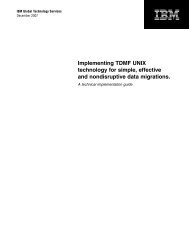A Primer for Healthcare Managers - IBM
A Primer for Healthcare Managers - IBM
A Primer for Healthcare Managers - IBM
Create successful ePaper yourself
Turn your PDF publications into a flip-book with our unique Google optimized e-Paper software.
18<br />
Phase 4: Transition to the Service Provider<br />
The transition of IT services from the client organization<br />
(or a previous vendor) to the contract winner is<br />
a demanding and time-consuming task. In addition<br />
to the general involvement of an organization in the<br />
development and implementation of IT services, the<br />
amount of transition ef<strong>for</strong>t depends on the scale of<br />
the project and independence of service units. The<br />
resource demand is high when the transition involves<br />
the servicing of a large number of units by the<br />
vendor. Transition is easier when the IT service in<br />
question is itself a more independent service unit.<br />
Following some guidelines should help the transition.<br />
The overarching principle should be the building of<br />
a long-term relationship based on mutual interest.<br />
In<strong>for</strong>mation needs to be shared, and open communication<br />
should be the norm. Ample resources also<br />
need to be allocated <strong>for</strong> carrying out the transition.<br />
The joint management team should provide financial<br />
and personnel support. The blueprint <strong>for</strong> the transition<br />
is outlined in the service-level agreement. The<br />
transition of the IT work<strong>for</strong>ce involves both operational<br />
and labor components.<br />
In<strong>for</strong>mation assurance should be a top item in the<br />
transition plan. When the in<strong>for</strong>mation and IT service<br />
change hands, they are likely to be more vulnerable<br />
to security breaches due to the involvement of<br />
multiple parties. There<strong>for</strong>e, the management team,<br />
in making the transition, should first identify threats<br />
to in<strong>for</strong>mation assurance in the transition stage.<br />
Threats may include, at a minimum, disgruntled<br />
employees, migration of data and documents, retirement<br />
of old IT equipment, and uncontrolled access<br />
to new threats.<br />
Operational documentation is critical in smoothing<br />
the transition from in-house to an outside vendor.<br />
One of the main barriers to transition is lack of<br />
documentation of work procedure and inventory.<br />
Vendors need to have a good understanding of<br />
work procedure and user needs in order to provide<br />
services. Moreover, the inventory of existing in<strong>for</strong>mation<br />
technology hardware and software related to<br />
the IT service in question is another critical document<br />
<strong>for</strong> the vendor. Another key piece of in<strong>for</strong>mation<br />
<strong>for</strong> service provision is baseline data on past service<br />
per<strong>for</strong>mance. This will help document the per<strong>for</strong>mance<br />
improvement brought by the vendor.<br />
A smooth transition also requires the constant attention<br />
of the management team that oversees<br />
the transition. Senior management members from<br />
both organizations need to remain committed<br />
through the entire process of transition (Goolsby,<br />
2002). Sustaining the management ef<strong>for</strong>t is important,<br />
because projects may take several years to<br />
complete the transition.<br />
Phase 4: Best Practices<br />
• Prepare proper documentation to smooth the<br />
transition. Proper documentation is needed<br />
<strong>for</strong> the relevant in<strong>for</strong>mation systems, service<br />
needs, and per<strong>for</strong>mance measures.<br />
• Devote resources to facilitating a transition.<br />
Human and financial resources should be in<br />
place <strong>for</strong> a transition.<br />
• Help the transition of in-house IT personnel.<br />
<strong>Managers</strong> need to provide training and career<br />
help <strong>for</strong> the IT personnel displaced by the<br />
outsourcing project.<br />
• Manage the transition with a strong<br />
management team. Strong leadership and<br />
management commitment are critical <strong>for</strong> the<br />
time of change.<br />
The management team should foster communication<br />
between the two organizations about problems associated<br />
with the transition and ideas about managing<br />
the transition. The management teams need to<br />
ensure that, at all steps of transition, actions taken<br />
should be in alignment with their strategic goals.<br />
Phase 5: Managing the Per<strong>for</strong>mance of<br />
the Service Provider<br />
Service delivery is the ultimate test of the outsourcing<br />
project, and management is the key to the success<br />
of an outsourcing relationship. Two principles guide<br />
the management of an IT outsourcing project. First,<br />
both the client organization and the vendor should<br />
take a collaborative approach. <strong>Managers</strong> need to<br />
know exactly what motivates the other party to<br />
provide service and proactively ensure that their<br />
mutual objectives are met (Goolsby, 2002). Second,<br />
both parties should be open to changes. The vendor<br />
in particular should be in a position to continuously<br />
improve its service by benchmarking best practices.<br />
The client organization in turn should be prepared to<br />
reengineer its business process to address<br />
changing demands.

















